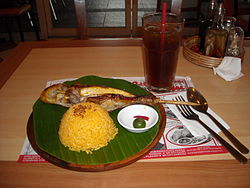


Chicken inasal served with sinangag
| |
| Alternative names | Hiligaynon: Inasal nga manok |
|---|---|
| Course | main course |
| Place of origin | Philippines |
| Region or state | Western Visayas |
| Serving temperature | hot |
| Main ingredients | chicken, lime, pepper, vinegar and annatto |
| Similar dishes | Inihaw |
Chicken inasal, commonly known simply as inasal, is a variant of the Filipino chicken dish known as lechon manok. Chicken inasal is a grilled chicken part usually breast (Pecho) or leg (Paa) while a lechon manok is a stuffed whole chicken. It is chicken marinated in a mixture of calamansi, pepper, coconut vinegar and annatto, then grilled over hot coals while basted with the marinade. It is served with rice, calamansi, soy sauce, chicken oil and vinegar (often sinamak vinegar, a palm vinegar infused with garlic, chili peppers and langkawas).
There are two popular versions of chicken inasal: the Bacolod and the Iloilo. The usual difference between them is that Bacolod's inasal has a slightly sour base flavor, while Iloilo's has a sweeter flavor, because of the addition of lechon sauce.[1]

One of the earliest documentations of chicken inasal was by Felix Laureano in his photo book, Recuerdos de Filipinas, which describes the daily lives and culture of Iloilo and Panay. The book published in 1895 in Madrid, Spain, listed inihao nga manuc as one of the items sold in the photo of a Calenderia, a store that sells food. Inihao nga manuc was described as pollo asado, Spanish for grilled or roasted chicken, which is now popularly known as chicken inasal.[2]
Banoy Velez from Oton, Iloilo, who started Velez Inasal, claimed to have introduced chicken inasal in Bacolod in 1946. The chicken inasal became widely popular in the 1970s on Bacolod's Cuadra Street (Chicken Alley).[3]

Chicken inasal is a common dish in the Visayas, it is a popular specialty in the city of Bacolod, where an entire street market is dedicated to local dishes, particularly inasal. A sign in the heart of the market reads "Manokan Country" (literally "Chicken Country" in Hiligaynon).[4]
Chicken inasal was declared a locally important cultural property of Bacolod on November 16, 2022.[3] On October 31, 2023, Iloilo City was recognized as UNESCO’s Creative City of Gastronomy. Iloilo listed chicken inasal as one of its food offerings.[5]

Among the popular restaurants serving chicken inasal are Bacolod Chicken Inasal, started by the Tanalgo sisters in Mandaluyong, and Mang Inasal, started by Edgar Sia in Iloilo City in 2003. Mang Inasal is the largest restaurant chain serving chicken inasal, with over 600 stores in the Philippines.[6]
en: a pavilion or kiosk made of bamboo with a nipa roof and walls selling "inihao nga manuc" or "pollo asado"
{{cite book}}: CS1 maint: location missing publisher (link)
This Filipino cuisine–related article is a stub. You can help Wikipedia by expanding it. |